
Zvezda 1/350 Submarine K-19 (Hotel class SSBN)
| KIT #: | 9025 |
| PRICE: | SEK 14500 (about Eur 16/$20.00 |
| DECALS: | Two options |
| REVIEWER: | Ingemar Caisander |
| NOTES: |

| HISTORY |
The Project 658 (NATO designation “Hotel I”) submarines were the first Soviet nuclear powered ballistic missile submarines (SSBN) in service, and between 1958 and 1960 a total of eight units were built at the 402 Sevmash shipyard at Severodvinsk.
The design was based on the Project 627 (November) SSN, adding the ballistic missile compartment from the Project 629 (Golf) SSB.
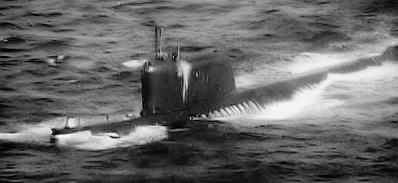 The three R-13 (SS-N-4
Sark) missiles were
placed in containers within the large sail, and the original D-2 launch system
made it necessary to surface and erect the missiles before launch. All three
missiles could be launched within 12 minutes after surfacing.
The three R-13 (SS-N-4
Sark) missiles were
placed in containers within the large sail, and the original D-2 launch system
made it necessary to surface and erect the missiles before launch. All three
missiles could be launched within 12 minutes after surfacing.
Beginning in 1963, the missiles were replaced by the R-21 (SS-N-5 Serb) and the D-4 launch system fitted – this enabled the submarine to launch the missiles from a depth of 16 meters while travelling at four knots. With this modification the submarines received the designation Project 658M (“Hotel II”).
The Project 658 submarine, of double hull construction and divided into ten compartments, had a length of 115 meters, a beam of 9.2 meters and displaced 4750 tons on the surface and 5600 tons submerged.
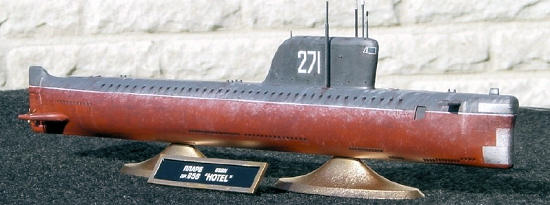 It was powered by two VM-A
pressurized water reactors supplying steam to two 60-D turbines, developing a
total of about 35.000 shaft horsepower. Two PG-116 electric motors (developing
900 shp) were also fitted for silent creep operations and emergency use.
It was powered by two VM-A
pressurized water reactors supplying steam to two 60-D turbines, developing a
total of about 35.000 shaft horsepower. Two PG-116 electric motors (developing
900 shp) were also fitted for silent creep operations and emergency use.
This power plant layout was similar to the one used on the Project 627 (November) SSN and the Project 659/675 (Echo I/II) SSGN.
Top speed underwater was 26 knots and the submarine had a maximum design diving depth of 300 meters, limited to 180 meters in operation and 240 meters maximum allowed.
Armament (besides the three ballistic missiles) consisted of four 533 mm bow torpedo tubes with four anti-ship torpedoes, and two 406 mm bow torpedo tubes with six anti-submarine torpedoes. A further pair of 406 mm torpedo tubes with six torpedoes was carried in the aft torpedo compartment.
The crew totalled between 90 and 104 men, and the submarine had an operational endurance of about 50 days.
In service the Project 658 submarines proved quite troublesome (especially with regards to the nuclear propulsion system), and the first unit, the infamous “K19”, had an amazing record of accidents during its operational career, with many crewmembers being killed or wounded.
The first major accident occurred already on the maiden voyage when, on the 4th of July 1961, the “K19” suffered a critical coolant leak in one of the reactors. The reactor core temperature rose uncontrollably, reaching almost 800 degrees C, before a team of eight engineering officers and crew, working without protection in high-radiation areas, managed to jury-rig a temporary emergency cooling system and bring the reactors back under control. The released radioactive steam and fission products contaminated part of the ship, and all eight men in the repair team died of massive radiation exposure within a week.
After the accident, the “K-19” was towed back to the home base and both reactors were subsequently removed and replaced, a process that took almost two years.
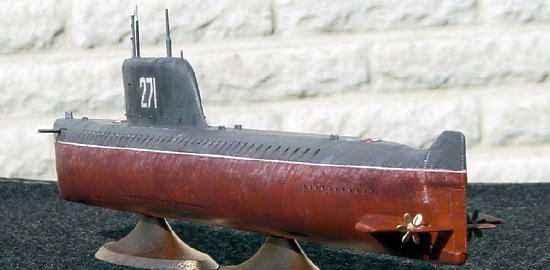 In 1964 the “K19” was returned
to service.
In 1964 the “K19” was returned
to service.
Then, on the 15th of November 1969, while operating in the Barents Sea at a depth of about 60 meters, the “K19” collided with the USS SSN615 Gato (a Permit class attack submarine).
The bow sonar systems were completely destroyed, as were the outer covers of the bow torpedo tubes – despite this the “K19” managed to emergency surface and limp back to home base.
Once again the ship was repaired and returned to service.
Then, on the 24 of February 1972, while operating some 700 nm off Newfoundland at a depth of about 120 m, a massive fire broke out caused by hydraulic fluid leaking onto a hot filter. The submarine surfaced and the fire was eventually extinguished, but the crew suffered horrendous losses with 28 fatalities.
A further 12 crewmembers became trapped in the aft torpedo room which became inaccessible due to conditions in the machine room. The submarine was assisted by surface ships and towed to Severomorsk, but due to a gale the operation was delayed and the trapped crew members could not be rescued until the 4th of April – they had then survived 24 days in the cold, pitch black aft torpedo room.
The ship was subsequently repaired and once again returned to service.
The “K19” was finally decommissioned in 1991, and in 1994 she was transferred to the naval yard at Polyarny. She remained there until March 2002, when she was towed to the Nerpa shipyard, Snezhnogorsk, Murmansk, where scrapping began about two years later.
| THE KIT |
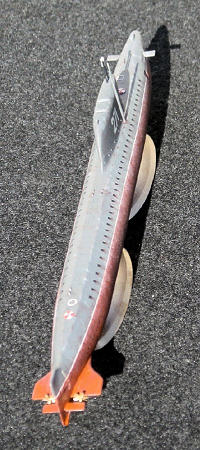 The kit contents are moulded in
black styrene and detailing is good as is the fit of parts. There was no flash
on any of the parts.
The kit contents are moulded in
black styrene and detailing is good as is the fit of parts. There was no flash
on any of the parts.
A stand for the completed model is included as well, this consist of two “feet” and a three-piece nameplate and is moulded in a semi-transparent blue styrene.
The decals are quite ok with the bow sonar panels being especially nicely textured.
Building instructions are logically laid out and there are no real tricky construction steps during assembly of the model.
Construction is pretty straightforward and begins with cementing the hull halves together. I had some problems with the after decking and in the end had to cut off about 1.5 mm at the mid point, in order to make the deck fit lengthwise within the constraints of the side hull halves.
Due to the double hull construction of the real thing, there are a multitude of free-flooding holes – as some of these are quite large they would benefit from being drilled out and a pressure hull added inside. I chickened out on this, though, only painting the openings flat black.
The sail consist of two side halves and a top piece, the latter including very nice engraved representations of the three missile hatches.
As is customary with most submarine models there are quite few parts, and at a rather relaxed building pace major assembly of the model was finished within two days – basically just leaving off some minor details (propellers, antennas and periscopes etc).
Fit of parts is quite good with only the rear edge of the sail and the propeller shaft assemblies requiring a slight touch of filler.
| COLORS & MARKINGS |
After general assembly was completed it was off to the paint booth.
As I was building this model off-site (that is, at my girlfriends place…), I did not have access to my ordinary selections of paints and instead had to make do with some no-name brand of car touch up paints.
The lower hull was finished in red primer, with the upper hull and sail in medium grey.
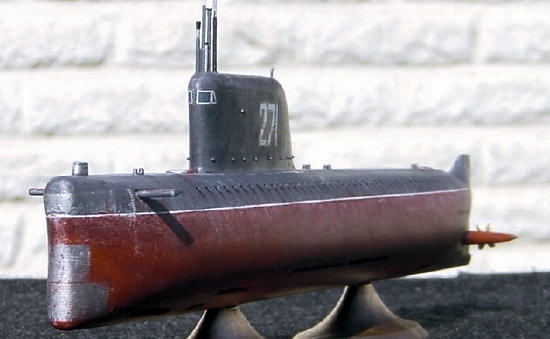 Detailing was picked out with
Humbrol paints; white for the waterline marking, flat black for the hull
free-flooding holes and silver for the various antennas and periscopes. The
propellers were spray-painted gold.
Detailing was picked out with
Humbrol paints; white for the waterline marking, flat black for the hull
free-flooding holes and silver for the various antennas and periscopes. The
propellers were spray-painted gold.
Then it was time for decals.
There isn’t really much with regards to markings for a submarine such as this; basically some load index scales (or surface level markings), the pennant number on the sail and the bow sonar panels. These latter are beautifully represented with a mesh pattern on the reverse side of the decals, giving a great scale representation of the sort of “webbed” appearance of the real thing.
The red-and-white hatch covers for the emergency buoys where slightly too large and difficult to make conform to the underlying surface, so in the end I gave up and painted them on instead.
I had the pennant numbers on the sail silvering badly quite, but this was probably my own fault since I didn’t put on a proper clear coat on the sail surface before applying the decals.
| FINAL CONSTRUCTION |
Late one evening, Anna (my girlfriend's daughter), promptly decided that the model would look much nicer and realistic if it was finished in sort of a worn state rather than in a pristine condition – so, said and done, heavy weathering it was!
The lower part of
the hull (below the surfaced waterline) was treated with a rust-like mix of
black, red, white and yellow paint, with
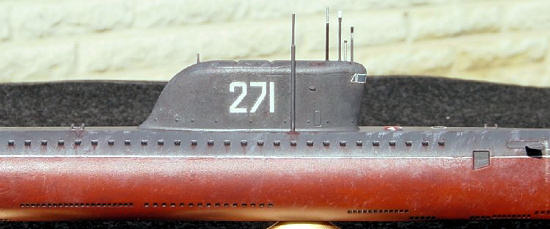 the area just below the waterline
being dabbed with light grey to simulate discolouration from sea tulips and the
like.
the area just below the waterline
being dabbed with light grey to simulate discolouration from sea tulips and the
like.
The upper hull, sail, and especially the areas directly below the free-flooding holes were also heavily treated with the rust-like colour mix, to give an impression of severe rust and corrosion.
Finally all the small details were added - antennas and periscopes, bow dive planes, and the propellers. Note that the propellers should rotate outwards, that is, when seen from behind the starboard propeller should rotate clockwise and the port one counter-clockwise (the instructions are a bit vague about this).
The last thing to do was to cement the submarine to the stand (previously painted in gold) and the model was completed.
| CONCLUSIONS |
This is a very nice model kit. As far as I can tell it is quite accurate with regards to the real thing, and thanks to the relatively small number of parts it would serve as a great introduction kit for anybody wanting to try their hands on a submarine model.
In addition, the rather unusual model subject is a very welcome addition to the collection of any Russian Navy buff.
In short, a great model kit of the first Russian class of “boomers”!
| REFERENCES |
Visits to U194 (Project 613/Whiskey-class SS), U484 (Project 651/Juliett-class SSG), various Internet resources, and the 2002 Touchstone/Buena Vista movie “K19 – The Widowmaker”)
October 2006
Copyright ModelingMadness.com If you would like your product reviewed fairly and fairly quickly, please contact the editor or see other details in the
Note to
Contributors.